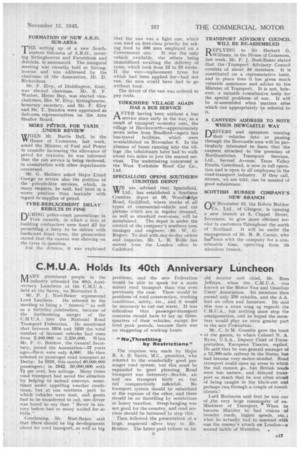C.M.U.A. Ho!ds Its 40th Anniversary Luncheon M ANY prominent people in
Page 19

If you've noticed an error in this article please click here to report it so we can fix it.
the industry attended the 40th Anniversary Luncheon of the C.M.U.A., held at the Savoy, on November 5. .
Mr. P. J. Noel-Baker represented Lord Leathers. He referred to the meeting as being a " funeral "as well as a birthday ,ceIebration, because of the forthcoming merger of the C.M.U.A., into the National Road Transport Federation. He mentioned that between 1934 and 1939 the total number of licensed vehiales had risen from 2,400,000 to 3,230,000. When Mr. F. G. Bristow, the General Secretary, joined the Association-3'7 years ago—there were only 4,000. He then referred to passenger road transport at Derby. In 1938, this carried 40,000,000 passengers ; in 1942, 50,000,000 with 7i per cent, less mileage. Many times road transport had saved the situation by helping to unload convoys, sometimes under appalling weather conditions, but at one northern port to which vehicles were sent, and goods had to be transferred to rail, one driver was heard to say that " Never in history before bad so many waited for so
little." .
Continuing, Mr. Noel-Baker said that there should be big developments ahead for road transport, as well as big problems, and the new Federation would be able to speak for a more united road transport than was ever. previously the case. There would be problems of road construction, working conditions, safety, :etc., and it would be necessary to cut out waste. It was ridiculous that passenger-transport concerns should have to lay up threequarters of their vehicles, except for brief peak periods, because there was no staggering of working hours.
." raft! ing by Restrictions"
The response was made by Major R. A, B. Smith, M.C. president, who referred to the wonderfully good passenger road system, but this must be, expanded to reieet planning. Road transport was extremely–flexible, air and sea transport fairly so, but. rail comparatively inflexible. No transport system should be subsidized at the expense of the other, and there should he no throttling by restrictions or heavy taxation. Strap-hanging was not good for the-country, and road services should be increased to stop this.
Then followed the presentation of a large, engraved silver tray to Mr. Bristow. The latter paid tribute to his old Mentor and chief, Mr. Rees Jeffreys, when the C.M.U.A. was known as the Motor Van and Omnibus Users' Association. Its members then owned only 230 vehicles, and the A.A. lent an office and furniture. He said this was a swan song as regards the C.M.U.A., but nothing must stop the amalgamation, and he hoped the members would play an even greater part in the new Federation.
Mr. C. le M. Gosselin gave the toast
• of the guests, to which Colonel N. A. Ryan, U.S.A., Deputy Chief of Trans-portation, European Theatre, replied. He said that he was general manager of a 12,000-mile railway in the States, but had become very motor-minded. Road transport could open up areas to which the rail cannot go, but British roads were too narrow, and delayed transport so much that he was often afraid of being caught in the black-out and
perhaps run, through a couple of round .. abouts !
Lord Brabazon said that he was one of ;the very large community of exMinisters of Transport. • When he became Minister he had visions a broader roads, higher speeds, etc.; what he actually had to contend with was the enemy's attack on London—a second battle of Waterloo. ,




















































